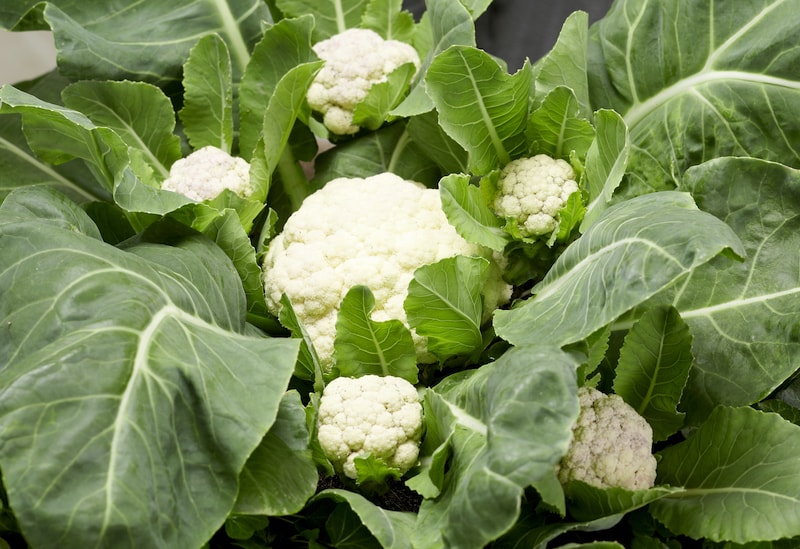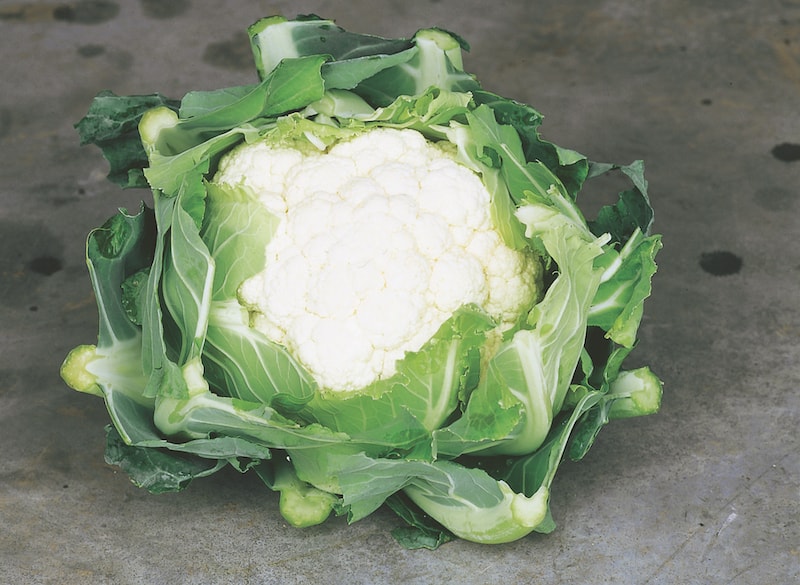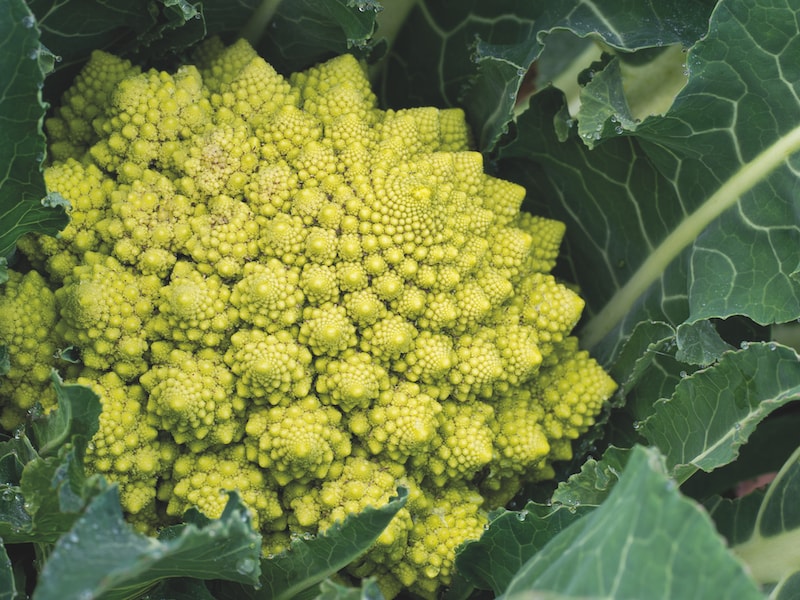For the best advice on growing cauliflowers, we’ve gathered together a collection of expert tips from the online horticultural world. These bloggers, YouTubers, and Instagrammers are well versed in the ins and outs of growing this wonderfully versatile vegetable. They’re also more than happy to share their knowledge to help you get the most from your cauliflower crop this season. And when you’re ready to have a go, browse our wide selection of cauliflower seeds for inspiration.
Contents:
- Best advice on growing cauliflowers from seed
- Best advice on planting out cauliflowers
- Best advice on caring for cauliflowers
- Best cauliflower varieties to try
- Best cauliflower recipes
Best advice on growing cauliflowers from seed

Image: Cauliflower Seeds ‘F1 Multi-Headed’ from Suttons
“A large white cauliflower with tight pure-white curds (the head) is truly a thing of beauty, and producing one is a source of great satisfaction,” says Simon Eade of Garden of Eaden. Although this brassica isn’t the easiest to grow, if you follow Simon’s instructions, you’re in with a great chance of getting it right. He says cauliflowers like firm soil or they tend to produce small ‘button heads’. Work in lots of manure the previous autumn and, “sow the seed thinly into the drills.”
If it’s a cold spring, you might wish to do as Adam Leone of Carrot Tops Allotment does – sow your cauliflower seeds in a cold frame. He says he “averages around four plants per cell and will look to thin these out when the seedlings start to poke through.” He also advises that you mark your cauliflower trays or rows carefully to avoid mix ups because the seeds look so similar to broccoli.
“The old Victorian Head Gardener would be able to provide a fresh cauliflower on demand every day of the year,” says John Harrison of Allotment and Gardens. With summer, autumn and winter varieties available, there’s no reason why, with good cultivation techniques, you can’t do the same. John advises that you sow cauliflower successionally into modules, “thinning them at seedling stage to one plant per module. Move them up to a larger pot when ready, this will prevent root disturbance – but don’t allow them to become pot bound.”
Over at Up The Plot, these veteran gardeners have worked their allotment for over a decade and have excellent cauliflower insights to share. Sowing early varieties indoors from February, and later varieties direct into the soil in 6mm deep drills, these guys say that overall, they find it best to nurture cauliflower seedlings at home before planting out: “I find it easier to look after the seedlings and young plants at home and the developed plants are more resistant to slugs and snails.”
Over at Claire’s Allotment, Claire presents an excellent Youtube video in which she demonstrates how to sow brassica seeds. She recommends part-filling a seed tray with compost (which you firm down and water) before sprinkling your cauliflower seeds sparsely over the surface. Claire says she always starts her brassicas off in the greenhouse, but a sunny windowsill works just as well.
Best advice on planting out cauliflowers

Image: Cauliflower Seeds ‘Di Sicilia Violetto’ from Suttons
Plant your summer and autumn cauliflower seedlings or plugs outside once they’ve developed three or four true leaves, says Georgina Starmer of Let’s Grow Wild. Again, making sure you’re planting into firm soil, space your plants about 18 inches apart. Georgina adds that “cauliflowers benefit from a mulch applied to the soil. It helps to suppress weeds and keep moisture in the soil.”
Over at Claire’s Allotment, Claire demonstrates how to prick out and replant cauliflower seedlings. She emphasises the importance of planting your seedlings deeply so that just the two little leaves of your seedlings are above soil level. First she fills a three inch pot with multipurpose compost then, using a pencil as a dibber, pokes a hole almost to the bottom. Finally, Claire teases loose a seedling, drops it into the hole and gently firms it in.
Best advice on caring for cauliflowers

Image: Cauliflower Seeds ‘F1 Clapton’ from Suttons
“If the cauliflower curd (the flower) is in too much light it will turn yellow,” writes Susan Garrett of gardening blog Ossett Weather. To stop this happening, she suggests bending the leaves over to cover the curd, blotting out the light and keeping that lovely centre nice and white. Susan also emphasises that to get a tight, good-sized cauliflower, conditions must be right – firm soil and plenty of water are key.
Cauliflowers are very prone to developing clubroot, says Simon Eade of The Garden of Eaden. If you have this fungal infection in your soil, you’re probably stuck with it but, Simon says, you can still grow cauliflowers provided you remove old brassica roots – including radishes, wild radishes, and mustard – and dispose of them in the rubbish or by burning to minimise the number of spores.
Cauliflowers are also susceptible to cabbage root fly, says John Harrison of Allotment and Gardens. This pest, which kills young plants and stunts more established ones, is easily identifiable: “Cabbage root fly will leave little tunnels in the roots and you may well find small white maggots eating away at the roots that will later blacken and die.” Luckily, John says, providing a barrier around the base of your brassicas prevents most problems. Check out his post to find out more.
“Net against pigeons and butterflies and be wary of slugs,” say the guys at Up The Plot. Offering some great harvesting advice, they recommend harvesting the curds as soon as they’re ready as they will soon ‘blow’, with the compact curds deteriorating into loose heads. “They [should] be firm, compact and between 15 cms and 30 cms across depending on the variety. Cut through the stem below the curd, a few leaves can be included as these can help to protect it.” Another top tip? Soak your cauliflower in slightly salted water to draw pests out before cooking or storing.
Best cauliflower varieties to try

Image: Cauliflower seeds ‘Romanesco’ from Suttons
Over at Allotment Haven, blogger Karen finds cauliflowers tricky to grow, calling them “the drama queens of the brassicas.” All the same, she likes to have a go, and if you check out her post, you’ll see that sometimes she has great success. As for variety, she swears by cauliflower ‘All The Year Round’.
“I didn’t even know about romanesco until I had it at a restaurant about ten years ago, and I remember staring at my plate in wonderment. What vegetable sorcery was this? I wondered,” recalls Sophie of Agents of Field. Romanesco is the cauliflower with the “intricate domes and spires that look like they belong atop St Basil’s Cathedral in Moscow.” It took Sophie’s partner, Ade, a few attempts to get it to grow, and romanesco does grow very slowly, but check out Sophie’s pics and tell us it wasn’t worth the effort. It’s spectacular.
If you’d be interested in growing a cauliflower with a difference, try lovely cauliflower ‘Di Sicilia Violetto’ which produces a delightful pale purple curd that’s hard to resist. “Ta-dah…cauliflower surprise,” says Rekha of @rekha.garden.kitchen as she showcases her scrumptiously crisp looking Italian beauty.
Cauliflower ‘Clapton’ is the first ever clubroot-resistant cauliflower, says John Harrison of Allotment and Gardens. Having taken 18 years to develop, he says: “Depending on its sowing time it matures from late summer to late autumn, producing large, excellent flavoured, solid, deep white heads of uniform quality.” Make sure you check out John’s post for lots more recommendations for summer, autumn, and winter caulis.
Best cauliflower recipes

Image: Cauliflower ‘All the Year Round’ seeds from Suttons
“Don’t expect bread-like crust, it really is just a suitable vehicle for carrying a topping; but do expect a delicious and very ‘pizza-like’ taste with a rather nice texture,” says Karen Burns-Booth of Lavender and Lovage. She’s talking about delicious, gluten-free cauliflower crust pizza which is an excellent alternative for anyone reducing or cutting out wheat and/or carbs. Do head over to Karen’s blog for the full recipe.
Showcasing her delicious-looking recipe for microwave vegan cauliflower mash, Kate of The Veg Space says: “There must have been a huge surge in cauliflower sales in the last five years or so, since everyone started getting giddy with excitement about cauliflower rice, cauliflower pizza bases, and cauliflower steaks.”
If you’re looking for a meat-free main that’s utterly delicious, you can’t go wrong with these vegan cauliflower quinoa meatballs courtesy of Janice of Farmersgirl Kitchen. Janice says, “They have a crisp crunchy coating and are soft inside. Serve with a spicy tomato and vegetable sauce spiced with the flavours of Mexico.”
If you like something with a bit of a kick, Hari’s spiced cauliflower rice is the perfect answer. A substitute for actual rice, her recipe is packed with warmth, flavour and colour. And while you’re visiting her website, Hari Ghotra, for the full recipe, take a peek at her whole baked cauliflower “fragranced with a decadent cashew nut paste.” Delicious!
We hope you’ve enjoyed our collection of cauliflower content, and that you’re ready to have a go at growing your own. If you prefer not to sow seeds, pick up a few cauliflower plug plants for a shortcut to success. And for more information and advice, head over to the Suttons blog.
Lead image: Cauliflower (Organic) Seeds ‘Skywalker F1’ from Suttons
Last Updated on December 11, 2024 by Suttons Horticultural Team




